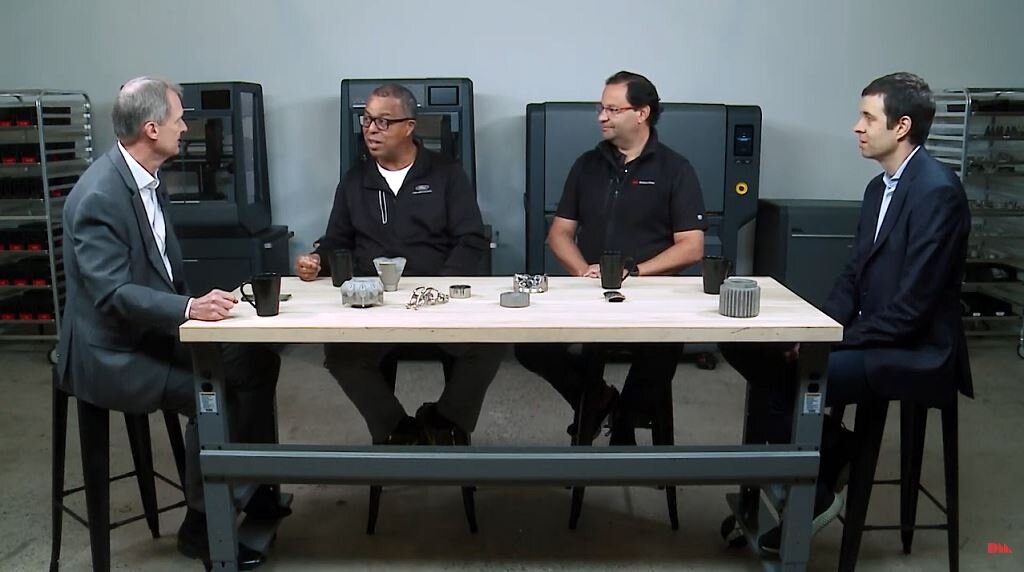![L-R: Terry Wohlers, Ken Washington, Ric Fulop, John Hart [Image: YouTube]](https://fabbaloo.com/wp-content/uploads/2020/05/dmmfgdayroundtable_img_5eb08f5172ef7.jpg) L-R: Terry Wohlers, Ken Washington, Ric Fulop, John Hart [Image: YouTube]
L-R: Terry Wohlers, Ken Washington, Ric Fulop, John Hart [Image: YouTube]
It’s National Manufacturing Day, perfect for a meeting of the minds to discuss additive manufacturing.
Desktop Metal is among the many companies in the 3D printing industry observing today’s festivities. Rather than spring for quick nice photo op and social media shoutout, the Boston-based company opted to bring together a few of the foremost experts in 3D printing to chat about the “next frontier for the manufacturing industry.”
Joining the roundtable are:
-
Terry Wohlers, President, Wohlers Associates
-
Ken Washington, Chief Technology Officer, Ford Motor Company
-
Ric Fulop, Co-Founder and CEO, Desktop Metal
-
John Hart, Professor of Mechanical Engineering, MIT
Normally to listen to this caliber of expertise, you might need to travel far (and pay a lot) to get to an industry conference. Rather than wait for Formnext or another such major opportunity, though, this roundtable is available online.
The 45-minute conversation:
Highlights
If you’re not interested in sitting through 45 minutes — even if it might get you into shape for the many conferences this autumn that you’ll hopefully be attending — we asked Desktop Metal what they thought some of the highlights are.
“I’m particularly excited about the next frontier of additive where we go from this subsegment of the market into mass production, into spare parts, into end use applications for components that essentially were traditionally made with other manufacturing techniques. Having additive penetrate and expand into all of these other applications, it’s a really exciting time in the industry. Where now it’s mature enough that you can design machines to actually take this technology into people’s products that you use every day,” Fulop says relatively early on in the chat.
As additive continues to make its way into manufacturing, a few major questions continue to linger, slowing adoption: how? Why?
Hart says:
“Manufacturing drives daily life in many ways, but in some ways it’s inefficient, requiring upfront costs and so on. To me, additive lets us rethink and reshape that, and figure out the little solutions and applications and so on. Me, as an academic and entrepreneur, it’s the opportunity to feed that back into education and research and solve the really hard problems that are needed to move the industry forward.”
As the industry moves forward, how capable are we, really, of predicting how it will look in the future? Did anyone really see 3D printing taking off — especially as an industrial-ready solution? Is it?
“If you had asked us 10 years ago, how far along we are with the adoption of the internet, you would’ve gotten that totally wrong. You wouldn’t have seen some of the applications of connected car, smart watches, Internet being used in advanced banking applications and bill pay and blockchain, you can go on and on and on. A lot of the applications hadn’t been thought of — and the designers hadn’t matured to the point where they were innovating and designing with the internet in mind. We were applying the internet to existing models and think we were almost there, but we weren’t. We missed that. I think additive manufacturing is going to be kind of like that, where you’re going to see an adoption of the mindset of designing for additive. You’re going to unlock all kinds of new innovations, new ways to bring products to life, new ways to design experiences for customers because you couldn’t do it before because you didn’t have the tools. Your imagination wasn’t unlocked by the promise of how you would build parts one layer at a time using multiple materials, using designs that nature could inspire you to do. We’re not even at the tipping point yet,” Washington says.
Wohlers facilitates the discussion to touch on some important topics as they look to the future of 3D printing and its impact on not only manufacturing, but on real human lives.
The full conversation is very much worth the listen.
Can we really predict the next decade of impact in manufacturing? Certainly not — but that’s not going to stop any of us from trying, especially as we honor manufacturing today.
Via YouTube

